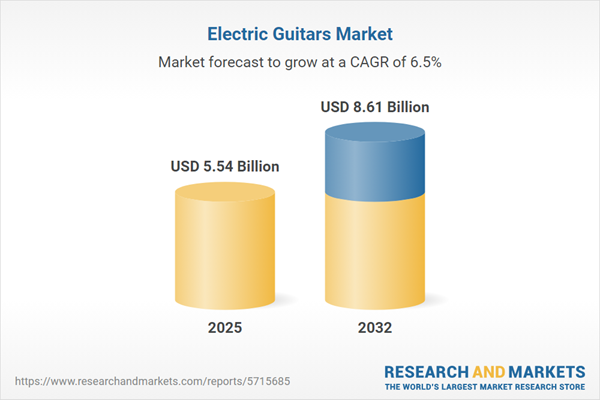Speak directly to the analyst to clarify any post sales queries you may have.
The electric guitar market is adapting swiftly as advanced technologies, shifting buyer expectations, and evolving supply chain models redefine industry standards. Senior leaders in music manufacturing, distribution, and retail face rising pressure to act on timely market research, realigning strategy, enhancing differentiation, and capturing growth in a changing musical ecosystem.
Market Snapshot: Growth Drivers and the Electric Guitar Market’s Competitive Landscape
The electric guitar market is advancing, propelled by increased global interest in music participation and the adoption of innovative digital technologies. Both well-established brands and new market entrants are driving competition by emphasizing digital integration and human-centered instrument design. Companies are realigning product development and streamlining operations to address diverse buyer needs and regional requirements. Innovation, flexibility in responding to shifting consumer tastes, and persistent improvements in user experience enable industry participants to maintain competitiveness and support the sector’s long-term expansion.
Scope & Segmentation: Influential Forces in the Electric Guitar Market
- Product Types: Includes hollow body, semi hollow body, and solid body models. Manufacturers employ premium tonewoods such as alder, basswood, and mahogany to design instruments that deliver tailored performance and distinct tonal profiles.
- Pickup Types: Covers humbucker, P90, and single coil configurations, supporting various sound characteristics across musical genres and playing approaches.
- String Counts: Offers six, seven, and twelve string variants to satisfy professional musicians and hobbyists, promoting individual expression and new musical directions.
- Distribution Channels: Encompasses manufacturer-direct ecommerce sites, retail stores, specialty dealers, and popular online marketplaces. The surge in digital sales platforms is reshaping customer purchasing journeys, heightening expectations for efficient and well-informed buying experiences.
- Customer Types: Addresses the requirements of hobbyists, students, and professionals, allowing brands to customize instruments and engagement strategies for each audience segment and boost repeat sales.
- Geographies: Spans the Americas, Europe, Asia-Pacific, and Middle East & Africa, where regional strategies are refined to fit cultural preferences, regulatory standards, and consumer behavior, supporting effective brand positioning on a global scale.
- Company Coverage: Features major stakeholders such as Fender Musical Instruments Corporation, Gibson Brands, Inc., Yamaha Corporation, Hoshino Gakki Co., Ltd., ESP Co., Ltd., Paul Reed Smith Guitars, Inc., Ernie Ball, Inc., Schecter Guitar Research, Inc., Armadillo Enterprises, Inc., and Cort Musical Instruments Co., Ltd.
Key Takeaways: Strategic Insights for Senior Decision-Makers
- Emphasis on digital features and ergonomic design enhances product portfolios and prioritizes operational efficiency, directly supporting evolving musician requirements.
- Digital-first selling and data-driven communications expand reach across buyer segments, improving the customer experience and strengthening brand loyalty.
- Growing preference for multi-string and custom-build options accelerates design innovations, encouraging broader market engagement and new playing styles.
- Tailored instruments and localized marketing initiatives respond to regional music trends and consumer habits, improving resonance in both established and developing markets.
- Collaboration among instrument makers, technology developers, and amplifier brands enables bundled product offerings, maximizing value for buyers and reinforcing competitive standing.
- Transparent sourcing and rigorous compliance with environmental standards position brands as credible, responsible partners, appealing to sustainability-focused customers and mitigating reputational risks.
Tariff Impact: Managing Policy Changes and Supply Chain Challenges
Variations in tariff regulations prompt manufacturers to diversify sourcing and refine production strategies in alignment with principal consumer regions. Advanced analytics tools are gaining prominence for tracking regulatory shifts and managing supply chain complexity, allowing rapid adaptation and compliance in this fluid policy environment.
Methodology & Data Sources
Findings are synthesized from executive interviews, musician feedback, and retail expert insights. Validation draws on industry statistics, comprehensive technical review, and recognized third-party research, delivering actionable guidance and confidence for strategic business decisions.
Why This Report Matters
- Presents actionable insights to drive innovation, optimize distribution networks, and inform resource allocation, enabling effective decision-making for business leaders.
- Supports rapid adjustment to evolving regulatory, regional, and technological shifts, equipping organizations to maintain compliance and competitive relevance.
- Facilitates benchmarking and evaluation of collaborative opportunities, empowering leaders to enhance performance and uncover potential for sustainable growth.
Conclusion
Staying in tune with ongoing industry transformation and evolving consumer demands strengthens organizational resilience. Leadership agility and responsive infrastructure will determine continued relevance and business success as the electric guitar sector develops.
Additional Product Information:
- Purchase of this report includes 1 year online access with quarterly updates.
- This report can be updated on request. Please contact our Customer Experience team using the Ask a Question widget on our website.
Table of Contents
3. Executive Summary
4. Market Overview
7. Cumulative Impact of Artificial Intelligence 2025
Companies Mentioned
The companies profiled in this Electric Guitars market report include:- Fender Musical Instruments Corporation
- Gibson Brands, Inc.
- Yamaha Corporation
- Hoshino Gakki Co., Ltd.
- ESP Co., Ltd.
- Paul Reed Smith Guitars, Inc.
- Ernie Ball, Inc.
- Schecter Guitar Research, Inc.
- Armadillo Enterprises, Inc.
- Cort Musical Instruments Co., Ltd.
Table Information
| Report Attribute | Details |
|---|---|
| No. of Pages | 183 |
| Published | November 2025 |
| Forecast Period | 2025 - 2032 |
| Estimated Market Value ( USD | $ 5.54 Billion |
| Forecasted Market Value ( USD | $ 8.61 Billion |
| Compound Annual Growth Rate | 6.4% |
| Regions Covered | Global |
| No. of Companies Mentioned | 11 |









